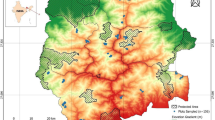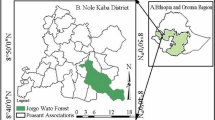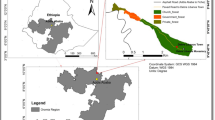Abstract
Despite the progression of land degradation and deforestation leading to vegetation fragmentation, most of the population in Mali are still strongly dependent on trees. The current study aimed at exploring how woody species diversity, density and regeneration varies with land use types (farmland, fallow and forest). The study also puts a particular focus on abundance, regeneration and distribution of Parkia biglobosa, a high value tree crop. Data were gathered through systematic vegetation surveys in 48 quadrat plots of 50 × 50 m distributed in three land use types. Ninety one woody species belonging to 72 genera and 30 families were recorded. Land use affected woody species regeneration, density and diversity and the structure of P. biglobosa. The highest mean number of species per plot was recorded in fallow (11.1 ± 1.5) and forest (10.8 ± 0.7) compared with farmland (6.9 ± 1.0). The most abundant regeneration individuals were recorded in the fallow (1998 ± 333 ha−1), followed by forest (1532 ± 167 ha−1) and farmland (897 ± 264 ha−1). For trees, the mean density of 99 ± 26 ind. ha−1 recorded in farmland is similar to fallow (156 ± 46 ha−1) but lower than forest (559 ± 133 ha−1). The lower Shannon’s diversity index H′ was also observed in the farmland (1.3 ± 0.1) compared with fallows (1.7 ± 0.2) and forests (1.9 ± 0.1). Spatial distribution of regeneration individuals for each species obtained from Morisita’s index showed aggregated patterns for most of the species while Canonical Correspondance Analysis showed more common species between fallow and forest. P. biglobosa trees growing in farmland had the greatest value (57.6 ± 7.0 cm) for collar diameter compared to that of forest (33.7 ± 4.6 cm) and fallow (31.2 ± 4.7 cm).







Similar content being viewed by others
References
Assemblée régionale Koulikoro (2008) Diagnostic régional de Koulikoro: Situation de référence sur base d’analyse documentaire. Ministère de l’administration territoriale et des collectivités locales, Région de Koulikoro, Mali, p 234. https://docplayer.fr/52724114-Diagnostic-regional-de-koulikoro.html
Augusseau X, Nikiema P, Torquebiau E (2006) Tree biodiversity, land dynamics and farmers’ strategies on the agricultural frontier of southwestern Burkina Faso. Biodivers Conserv 15:613–630
Bagnoud N, Schmithüsen F, Sorg JP (1995) Les parcs à Karité et Néré au Sud-Mali : analyse du bilan économique des arbres associés aux cultures. Bois et Forets des Tropiques 244:9–23
Bayala J, Teklehaimanot Z, Ouedraogo SJ (2002) Millet production under pruned tree crowns in a parkland system in Burkina Faso. Agrofor Syst 54:203–214
Bazié P, Ky-Dembele C, Jourdan C, Roupsard O, Zombré G, Bayala J (2019) Synchrony in the phenologies of fine roots and leaves of Vitellaria paradoxa in different land uses of Burkina Faso. Agrofor Syst 93:449–460
Bellefontaine R (1997) Synthèse des espèces des domaines sahélien et soudanien qui se multiplient naturellement par voie végétative. In: d’Herbès JM, Ambouta K, Peltier R (eds) Fonctionnement et gestion des écosystèmes forestiers contractés sahéliens. John Libbey Eurotext, Paris, pp 95–104
Birnbaum P (2012) Biodiversité au Sahel: Les forêts du Mali. Versailles, Ed. Quae, France, p 174 (ISBN 978-2-7592-1811-0)
Boffa JM (1999) Agroforestry parklands in sub-Saharan Africa. FAO conservation guide no. 34. FAO, Rome
Boffa JM (2000) West African agroforestry parklands: keys to conservation and sustainable management. Unasylva—no. 200—trees outside forests. http://www.fao.org/3/x3989e/x3989e04.htm
Bognounou F, Thiombiano A, Savadogo P, Boussim JI, Oden PC, Guinko S (2009) Woody vegetation structure and composition at four sites along a latitudinal gradient in Western Burkina Faso. Bois et Forêts des Tropiques 300(2):29–44
Brandt M, Rasmussen K, Hiernaux P, Herrmann S, Tucker CJ, Tong X, Tian F, Mertz O, Kergoat L, Mbow C, David JL, Melocik KA, Dendoncker M, Vincke C, Fensholt R (2018) Reduction of tree cover in West African woodlands and promotion in semi-arid farmlands. Nat Geosci 11:328–333
Brito JC, Godinho R, Martinez-Freiria F, Pleguezuelos JM, Rebelo H, Santos X, Vale CG, Velo-Anton G, Boratynski Z, Carvalho SB, Ferreira S, Goncalves DV, Silva TL, Tarroso P, Campos JC, Leite JV, Nogueira J, Alvares F, Sillero N, Sow AS, Fahd S, Crochet PA, Carranza S (2014) Unravelling biodiversity, evolution and threats to conservation in the Sahara-Sahel. Biol Rev 89:215–231
Cissé S (2000) Stratégie nationale en matière de diversité biologique. In: Meateu P (ed) Ministère de l’Equipement de l’Aménagement du Territoire de l’Environnement et de l’Urbanisme, Bamako, Mali, p 123. https://www.cbd.int/doc/world/ml/ml-nbsap-01-p2-fr.pdf
Cuny P, Sorg JP (2003) Forêt et coton au sud du Mali: cas de la commune rurale de Sorobasso. Bois et Forêts des Tropiques 276:17–30
Dayamba SD, Djoudi H, Zida M, Sawadogo L, Verchot L (2016) Biodiversity and carbon stocks in different land use types in the Sudanian Zone of Burkina Faso, West Africa. Agr Ecosyst Environ 216:61–72
Etongo D, Djenontin INS, Kanninen M, Glover EK (2017) Assessing use-values and relative importance of trees for livelihood values and their potentials for environmental protection in Southern Burkina Faso. Environ Dev Sustain 19:1141–1166
Food and Agriculture Organization (FAO) (2006) Global forest resource assessment 2005. Food and Agriculture Organization of the United Nations, Rome
Food and Agriculture Organization (FAO) (2010) Global forest resources assessment 2010. Food and Agriculture Organization of the United Nations, Rome
Fontès J, Guinko S (1995) Carte de la végétation et de l´occupation du sol du Burkina Faso. P. (M. de la coopération francaise, Ed.). Ministère de la coopération francaise, Paris
Gautier D, Bazile D, Picard N (2006) Interactions between Sahelo-soudanian savannas and parklands in space and time. How it affects biomass and biodiversity in regards to stakeholder strategies. In: Mistry J, Berardi A (eds) Placing people back into nature: lessons from savannas and dry forests. Ashgate, London, pp 227–240
Gerhardt K, Todd C (2009) Natural regeneration and population dynamics of the tree Afzelia quanzensis in woodlands in Southern Africa. Afr J Ecol 47:583–591
Gijsbers HJM, Kessler JJ, Knevel MK (1994) Dynamics and natural regeneration of woody species in farmed parklands in the Sahel region (Province of Passore, Burkina Faso). For Ecol Manage 64:1–12
Gonzalez P, Tucker CJ, Sy H (2012) Tree density and species decline in the African Sahel attributable to climate. J Arid Environ 78:55–64
Hänke H, Börjeson L, Hylander K, Enfors-Kautsky E (2016) Drought tolerant species dominate as rainfall and tree cover returns in the West African Sahel. Land Use Policy 59:111–120
Kaboré SA, Bastide B, Traoré S, Boussim JI (2012) Dynamique du karité, Vitellaria paradoxa, dans les systèmes agraires du Burkina Faso. Bois et Forets des Tropiques 313:47–59
Kater LJM, Kante S, Budelman A (1992) Karite (Vitellaria-Paradoxa) and Nere (Parkia-Biglobosa) Associated with Crops in South Mali. Agrofor Syst 18:89–105
Kauppi A, Rinne P, Ferm A (1988) Sprouting ability and significance for coppicing of dormant buds on Betula pubescens Ehrh. stumps. Scand J For Res 3:343–354
Keita B (2000) Les sols dominants du Mali. Quatorzième réunion du Sous-Comité ouest et centre africain de corrélation des sols. Food and Agriculture Organization of the United Nations, Rome. http://www.fao.org/tempref/docrep/fao/005/y3948f/y3948f04.pdf
Kelly BA, Bouvet JM, Picard N (2004) Size class distribution and spatial pattern of Vitellaria paradoxa in relation to farmers’ practices in Mali. Agrofor Syst 60:3–11
Kindt R, Kalinganire A, Larwanou M, Belem M, Dakouo JM, Bayala J, Kaire M (2008) Species accumulation within land use and tree diameter categories in Burkina Faso, Mali, Niger and Senegal. Biodivers Conserv 17:1883–1905
Kouyaté AM, Meyer A, Van Damme P (2002) Perceptions paysannes de Detarium microcarpum Guill. et Perr. dans le sud du Mali. Fruits 57:305–312
Krebs J (1999) Ecological Methodology. AddisonWesley Educational Publishers Inc, New York
Ky-Dembele C, Tigabu M, Bayala J, Ouedraogo SJ, Oden PC (2007) The relative importance of different regeneration mechanisms in a selectively cut savanna-woodland in Burkina Faso, West Africa. For Ecol Manage 243:28–38
Lamien N, Ouédraogo SJ, Diallo OB, Guinko S (2004) Productivité fruitière du karité (Vitellaria paradoxa Gaertn. C. F., Sapotaceae) dans les parcs agroforestiers traditionnels au Burkina Faso. Fruits 59:1–7
Lamien N, Ekué M, Ouedraogo M, Loo J (2011) Parkia biglobosa, African locustbean: conservation and sustainable use of genetic resources of priority food tree Species in sub-Saharan Africa. Bioversity International, Rome
Larwanou M, Saadou M (2011) The role of human interventions in tree dynamics and environmental rehabilitation in the Sahel zone of Niger. J Arid Environ 75:194–200
Leps J, Smilauer P (2003) Multivariate analysis of ecological data using CANOCO. Cambridge University Press, Cambridge
Lompo D, Vinceti B, Konrad H, Gaisberger H, Geburek T (2018) Phylogeography of African Locust Bean (Parkia biglobosa) reveals genetic divergence and spatially structured Populations in West and Central Africa. J Hered 1099:811–824
Maes WH, Achten WMJ, Reubens B, Raes D, Samson R, Muys B (2009) Plant-water relationships and growth strategies of Jatropha curcas L. seedlings under different levels of drought stress. J Arid Environ 73:877–884
Magurran AE (2004) Measuring biological diversity (Blackwell). Malden, Oxford and Victoria, p 256
Maisharou A, Chirwa PW, Larwanou M, Babalola F, Ofoegbu C (2015) Sustainable land management practices in the Sahel: review of practices, techniques and technologies for land restoration and strategy for up-scaling. Int For Rev 17:1–19
Maranz S (2009) Tree Mortality in the African Sahel Indicates an Anthropogenic Ecosystem Displaced by Climate Change. J Biogeogr 36:1181–1193
Nenova S, Behrend H (2016) (Em)powering people: reconciling energy security and land-use management in the sudano-sahelian region. In: Chabay I, Frick M, Helgeson J (eds) Land restoration, chap 1.3. Academic Press, Boston, pp 27–66
Nikiema A (2005) Agroforestry parkland species diversity: uses and management in semi-arid West-Africa (Burkina Faso). University of Wageningen, Wageningen, p 102
Nikiema A, van der Maesen LJG, Hall JB (2005) Woody species composition of Sudan savanna parklands in relation to rural land use gradients in Burkina Faso. In: Universigy W (ed) Agroforestry parkland species diversity: uses and management in semi-arid West Africa (Burkina Faso). Wageningen Universigy, Wageningen, pp 8–22
Nouvellet Y, Sylla ML, Kassambara A (2003) La production de bois d´énergie dans les jachères au Mali. Bois et Forets des Tropiques 276:5–15
Nouvellet Y, Kassambara A, Besse F (2006) Le parc à karités au Mali: inventaire, volume, houppier et production fruitière. Bois et Forets des Tropiques 287:5–20
Orwa C, Mutua A, Kindt R, Jamnadass R, Anthony S (2009) Parkia biglobosa. Agroforestree database: a tree reference and selection guide version 4.0 (http://www.worldagroforestry.org/sites/treedbs/treedatabases.asp)
Paré S, Söderberg U, Sandewall M, Ouadba JM (2008) Land use analysis from spatial and field data capture in southern Burkina Faso, West Africa. Agr Ecosyst Environ 127:277–285
Pearce DW (2001) The economic value of forest ecosystems. Ecosyst Health 7:284–296
Raebild A, Hansen U, Kambou S (2012) Regeneration of Vitellaria paradoxa and Parkia biglobosa in a parkland in Southern Burkina Faso. Agrofor Syst 85:443–453
Savadogo P, Zida D, Sawadogo L, Tiveau D, Tigabu M, Oden PC (2007) Fuel and fire characteristics in savanna-woodland of West Africa in relation to grazing and dominant grass type. Int J Wildl Fire 16:531–539
Savadogo P, Sanou L, Dayamba S, Bognounou F, Thiombiano A (2017) Relationships between soil seed banks and above-ground vegetation along a disturbance gradient in the W Park trans-boundary biosphere reserve. West Africa. J Plant Ecol. 10:349–363
Sawadogo L (2007) Etat de la biodiversité et de la production des ligneux du chantier d´amenagement forestier du Nazinon après une vingtaine d´année de pratiques d´aménagement. Center for International Forestry Research (CIFOR), Bogor, p 42
Schmidt M, Mbayngone E, Bachmann Y, Hahn K, Zizka G, Thiombiano A (2016) The impact of land use on species composition and habitat structure in Sudanian savannas—a modelling study in protected areas and agricultural lands of southeastern Burkina Faso. Candollea 71:265–274
Schreckenberg K (1999) Products of a managed landscape: non-timber forest products in the parklands of the Bassila region, Benin. Glob Ecol Biogeogr 8:279–289
Sina S (2006) Reproduction et diversity génétique chez Parkia biglobosa (Jacq.) G. hD Dissertation. Wageningen University, Wageningen
Sina S, Traoré SA (2002) Parkia biglobosa (Jacq.) R.Br. ex G. Don. In: Oyen LPA, Lemmens RHMJ (eds) PROTA (Plant resources of tropical africa/ressources végétales de l’Afrique tropicale), Wageningen, The Netherlands. https://uses.plantnet-project.org/fr/Parkia_biglobosa_(PROTA)
Sinare H, Gordon LJ (2015) Ecosystem services from woody vegetation on agricultural lands in Sudano-Sahelian West Africa. Agr Ecosyst Environ 200:186–199
Teklehaimanot Z (2004) Exploiting the potential of indigenous agroforestry trees: Parkia biglobosa and Vitellaria paradoxa in sub-Saharan Africa. Agrofor Syst 61:207–220
ter Braak CJF, Smilauer P (2002) CANOCO reference manual and CanoDraw for windows user’s guide: software for canonical community ordination (version 4.5). Microcomputer Power, Ithaca
UNCTAD (2015) Climate change, biodiversity and livelihoods: lessons learnt from UNCTAD project implementation. United Nations Conference on Trade And Development, (UNCTAD), Geneva. https://unctad.org/en/PublicationsLibrary/ditcted2015d3_en.pdf
Wezel A, Lykke A (2006) Woody vegetation change in Sahelian West Africa: evidence from local knowledge. Environ Dev Sustain 8:553–567
Yacouba B, Wang Z, Boubacar Y (2016) Land-use and land-cover change in the Sahel Area of Keita Valley, Republic of Niger. J Environ Protect 7:554–565
Acknowledgements
Funding for this study was provided by the Genebank funds of the World Agroforestry Centre (ICRAF). Special thanks to Modibo Doumbia, Modibo Keita and Fatoumata Traoré for assistance in the field, to Domo Dolo for assistance in the field and for drawing the map, and to Assamou Diallo for driving the team to the field.
Author information
Authors and Affiliations
Corresponding author
Rights and permissions
About this article
Cite this article
Ky-Dembele, C., Dayamba, S.D., Savadogo, P. et al. Land use dictates diversity, density and regeneration of woody species in southwestern Mali, West Africa. Trop Ecol 60, 114–128 (2019). https://doi.org/10.1007/s42965-019-00015-2
Published:
Issue Date:
DOI: https://doi.org/10.1007/s42965-019-00015-2




